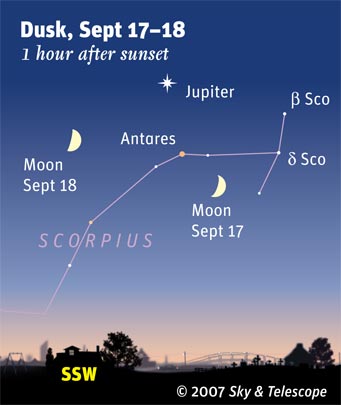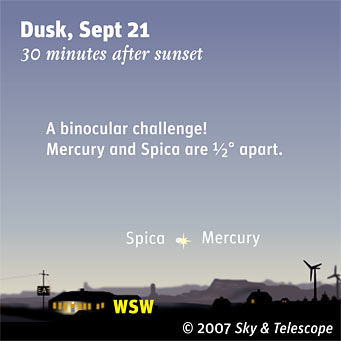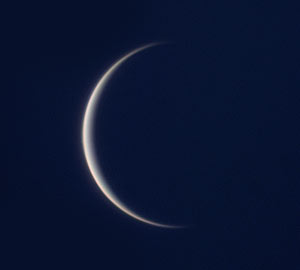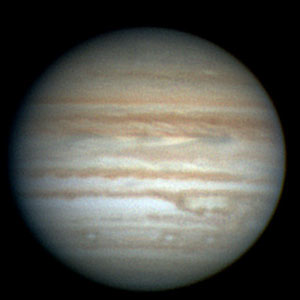Some daily events in the changing sky for September 14 – 22.

Watch the Moon triangulating on Jupiter and Antares around midweek. (These scenes are drawn for the middle of North America. European observers: move each Moon symbol a quarter of the way toward the one for the previous date. For clarity, the Moon is shown three times actual size.)
Sky & Telescope diagram
Friday, September 14
Saturday, September 15
Sunday, September 16
Monday, September 17
Tuesday, September 18
Wednesday, September 19
Thursday, September 20
Friday, September 21
Saturday, September 22

Use binoculars to catch Mercury and Spica in conjunction on Friday evening the 21st. (Their exact positions with respect to each other will depend on where you are.) The old rule is that stars twinkle and planets don't, but when you're viewing through this much of Earth's unsteady atmosphere, even a planet is likely to twinkle a bit.
Sky & Telescope diagram
Want to become a better amateur astronomer? Learn your way around the constellations. They're the key to locating everything fainter and deeper to hunt with binoculars or a telescope. For an easy-to-use constellation guide covering the whole evening sky, use the big monthly foldout map in each issue of Sky & Telescope, the essential magazine of astronomy. Or download our free Getting Started in Astronomy booklet (which only has bimonthly maps).
Once you get a telescope, to put it to good use you'll need a detailed, large-scale sky atlas (set of maps; the standard is Sky Atlas 2000.0) and good deep-sky guidebooks (such as Sky Atlas 2000.0 Companion by Strong and Sinnott, the even more detailed Night Sky Observer's Guide by Kepple and Sanner, or the enchanting though somewhat dated Burnham's Celestial Handbook). Read how to use them effectively.
More beginners' tips: "How to Start Right in Astronomy".
This Week's Planet Roundup
Mercury (magnitude 0) is deep in the glow of sunset, in the midst of a poor apparition for the Northern Hemisphere. Try looking for it with binoculars about 20 minutes after sundown just above the horizon — due west early in the week, west-southwest at week's end. Day by day, watch Mercury closing in on fainter, sparklier Spica to its upper left. Spica and Mercury come to a close conjunction on Friday the 21st, as shown above.

Venus was still a very a thin crescent just 14° from the Sun when Sean Walker took this stacked video image, using a 12.5-inch Newtonian reflector, after sunrise on August 30, 2007. He boosted contrast to darken the blue sky.
S&T: Sean Walker
Venus (magnitude –4.7) shines in the east at dawn, getting higher every day. A telescope shows that it's a crescent, waxing in phase as Venus always does when you see it as the "Morning Star."
Mars (magnitude +0.1, between the horns of Taurus) rises around 11 p.m. daylight saving time and shines very high in the southeast before dawn. Compare its fiery color with that of fainter Aldebaran to its upper right late at night, and with th color of Betelgeuse a similar distance to Mars's lower right.
In a telescope Mars is gibbous and 9 arcseconds in diameter. It will reach 16" diameter around its Christmas-season opposition. The last couple months of Martian dust storms have abated, and while the planet's atmosphere is still bright and hazy with dust, surface features are showing through a little better. But they're still low-contrast; don't expect to see much, especially with Mars still so small.

The Martian air is clearing. On the morning of September 13th, Sean Walker shot this view showing the dark band of Mare Tyrrhenum (left) and Mare Cimmerium (center to lower right). Jutting up from Mare Cimmerium, just lower right of center, are the two little prongs of Gomer Sinus (actually, Gomer Sinus is just the one on the right) — well-known among Mars observers as an indicator of excellent resolution. North is up, celestial east is left.
S&T: Sean Walker
Jupiter (magnitude –2.1, in southern Ophiuchus) glares in the south-southwest during twilight and sets around midevening. Get your telescope on it as early in twilight as you can. Antares, less bright, sparkles redly 6° or 7° below it.
Saturn (magnitude +0.7) is low in the glow of sunrise, about 16° lower left of brilliant Venus. If you pick up Saturn in binoculars or a wide-field scope, you can see that it's within 2° or 3° of twinkly Regulus (magnitude +1.4). Regulus is to Saturn's upper right.
Uranus (magnitude 5.7, in Aquarius) and Neptune (magnitude 7.8, in Capricornus) are well placed in the southeast to south during evening. Finder charts for them are in the July Sky & Telescope, page 60, and online.

Jupiter is bidding telescopic observers a long farewell, but even so, Christopher Go caught this fine shot on September 2nd (at 10:35 UT) from his low latitude in the Philippines. North is up. The South Equatorial Belt has become a pair of narrow dark lines separated by a wide white zone (at least on this side of Jupiter). Lower right of center, South Tropical Disturbance #1 is very prominent.
Christopher Go
Pluto (magnitude 14.0, in the northwestern corner of Sagittarius) is already starting to creep down in the south-southwest when darkness falls. It's about 15° east-northeast of Jupiter. If you have at least an 8-inch scope and a good sky, try for Pluto while you still can. A finder chart is in the July Sky & Telescope, page 60.
All descriptions that relate to your horizon — including the words up, down, right, and left — are written for the world's midnorthern latitudes. Descriptions that also depend on longitude (mainly Moon positions) are for North America. Eastern Daylight Time (EDT) equals Universal Time (UT, UTC, or GMT) minus 4 hours.
To be sure you get the current Sky at a Glance, bookmark this URL:
http://SkyandTelescope.com/observing/ataglance?1=1
 0
0
Comments
You must be logged in to post a comment.